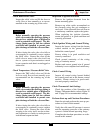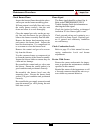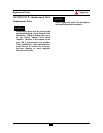
60
Maintenance Procedures
Check Combustion/ Ventilation A i r O p e n i n g s
Verify that all combustion air and ventila-
tion openings to the mechanical room or
building are open and unobstructed. Check
the operation and wiring of any automatic
ventilation dampers.
Check and verify the vent discharge and the
combustion air intake are free of debris and
obstructions.
Inspect Vent System and Combustion Air
Piping
Visually inspect the venting system and
combustion air piping (if installed) for
blockage, deterioration or leakage. Repair
any vent joints that show signs of deterio-
ration as per the vent manufacturer’s
instructions.
When combustion air is ducted to the unit,
verify that the air inlet piping is connected
and sealed. Inspect the air hose connecting
the air inlet adapter to the venturi elbow for
deterioration.
Failure to inspect the vent system and
combustion air inlet piping and have any
conditions repaired can result in severe
personal injury or death.
Check Primary System
Verify all system components are correctly
installed and operating correctly.
Check the cold fill pressure for the system,
typical cold water fill pressure is 12 psig.
Verify the system pressure as the unit oper-
ates at high temperature to ensure the pres-
sure does not exceed 25 psig. Excessive
pressure reading indicates expansion tank
sizing is incorrect or system performance
p r o b l e m s .
Inspect air vent and air separators in the
system. Remove the caps on automatic air
vents and briefly depress the valve stem to
flush vent. Replace the cap when complet-
ed. Ensure vents do not leak, replace any
leaking vents.
Check Domestic System
Verify all system components are correctly
installed and operating correctly.
Check the outlet domestic temperature of
the mixing valve and compare with the
recorded temperature made during start-up.
Check Expansion Tank
Refer to Section V - Primary Piping for
recommended location of the expansion
tank and air eliminators.
Close -Type Tank:
- Ensure tank is partially filled with
water leaving an air gap as a cushion.
Refer to the manufacturer’s instruction
for proper fill level.
- Ensure the tank is fitted with a device
that reduces gravity circulation of air-
saturated tank water back into the sys-
tem. This device prevents air from
bubbling up through the water as it
returns from the system.
- Ensure no automatic air vents are used
in the system. This will allow air to
escape from the system instead of
returning to the tank.
Diaphragm Tank:
- Ensure the system contains a minimum
of one automatic air vent. Preferred
location of the air vent should be atop
an air eliminator.
- Remove the tank from the system and
check the charge pressure. For residen-
tial applications the charge pressure is
typically 12 psig. If tank does not hold
a charge pressure, then the membrane is
damaged and the tank should be
replaced.
WARNING


















